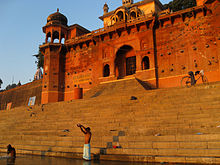The Varanasi Heritage Dossier/Chet Singh Ghat and Palace
Detailed description of each heritage Site - Prabhu Ghat to Kedara Ghat

Location
[edit | edit source]25º 17.621’ North and 83º 00.380’ East (entrance point at the Ghat).
Exact location on a map
[edit | edit source]Chet Singh Ghat, Shivala area.
Area
[edit | edit source]0.47ha
Historical/cultural/natural significance
[edit | edit source]Chet Singh (1770-1781) built the palatial building of Chet Singh Ghat in mid the 18th century as a small fortress, which witnessed the fierce battle between the troops of Warren Hastings and Chet Singh in 1781 that resulted to the defeat of Chet Singh. Thus this fortress went under the control of British. In late 19th century the King Prabhunarayan Singh had again took the possession of this fort. The northern part of it was donated to Naga group of ascetics who late on built their monasteries and ghats, called Niranjani Ghat and Nirvani Ghat.
=== Description and History ===: This palace has been his principal residence. This building composed of (a) a palace with pavilions, built on the terrace overlooking the Ganga, (b) a group of buildings for the women (demolished), and (c) a Mughal garden with darbar and water tower. The palace has a particularly favoured relationship to the Ganga. It opens out onto the ghat which are a continuation of the palace and reached by means of a monumental gateways. The gateway houses a stairway, which gives access to the terrace. There, a central pavilion stands looking out over the Ganga, on which the Maharaja appeared for glimpse. The terraced level is defined at two corners by two massive structures tapped by octagonal domed pavilions. There are three state temples of Shiva in the compound, built in 18th-19th century.
Present state of conservation
[edit | edit source]
Lack of knowledge of the ancient rich heritage, resulted to several ugly construction, and repairing. The ascetics living there, or the incharge looking after the temple-monastery are conservative people and never listen to others. Moreover, taking benefit of loose rules and loopholes so many addition in built area added which threaten the aesthetics and ancient glory of heritage.
Specific measures being taken for conserving the specific property
[edit | edit source]No specific measures are taken to conserve and preserve the palace and its compound, except that once or twice in an year for some celebrations the palace is allotted and on that very occasions cleaning, white washing and some repairing are done.
Ownership
[edit | edit source]The Kashiraj Trust of the Maharaja, own this palace and area like other properties of the estate.